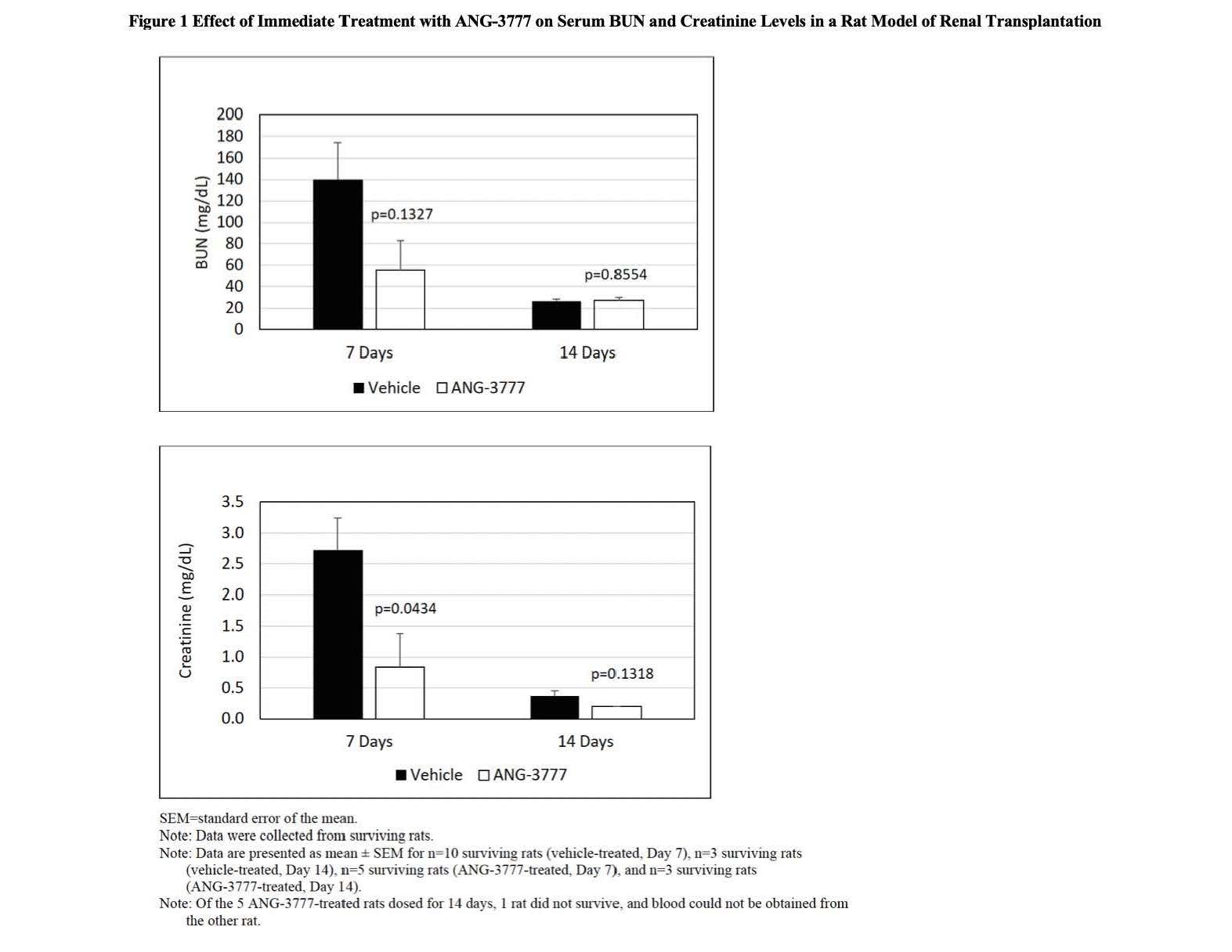ANG-3777, A Hepatic Growth Factor Mimetic, Attenuates Post-Transplant Renal Dysfunction in Rats
Angion Biomedica, Uniondale, NY
Meeting: 2020 American Transplant Congress
Abstract number: C-359
Keywords: Growth factors, Kidney/liver transplantation, Rat, Renal dysfunction
Session Information
Session Name: Poster Session C: Ischemia Reperfusion & Organ Rehabilitation
Session Type: Poster Session
Date: Saturday, May 30, 2020
Session Time: 3:15pm-4:00pm
 Presentation Time: 3:30pm-4:00pm
Presentation Time: 3:30pm-4:00pm
Location: Virtual
*Purpose: ANG-3777, a small-molecule mimetic of hepatocyte growth factor (HGF), has the potential to exert antifibrotic and nephroprotective effects. A rat model of renal transplantation evaluated effects of ANG-3777 on post-transplantation renal function and survival 1) when added to organ preservation fluid and 2) after intraperitoneal (IP) injection to renal transplant recipient.
*Methods: Adult male Lewis rats (n=15) were used as donors and recipients in a syngeneic model of renal preservation and transplantation following 4 hrs of cold preservation, with recipient contralateral nephrectomy. Left kidneys were preserved for 4 hrs in the University of Wisconsin Solution at 4°C in vehicle or ANG-3777 (10 μM). The non-transplanted kidney was removed, and recipient rats were treated daily with vehicle (n=10) or ANG-3777 (2 mg/kg IP; n=5) for 2 weeks until sacrifice on Day 14 following transplantation. Renal function, measured by blood urea nitrogen (BUN) and creatinine levels, and survival were recorded on Day 7 and Day 14 post-‑transplantation.
*Results: ANG-3777 improved renal function (Fig. 1). Preservation of donor kidney with ANG-3777 in conjunction with treatment of recipient rats with IP ANG-3777 reduced serum creatinine and BUN levels on Day 7 post-transplantation vs preservation and treatment with vehicle (p<0.05 for serum creatinine levels). By Day 14, serum creatinine and BUN returned to normal levels, with no significant difference between vehicle- and ANG-3777-treated rats. ANG-3777 treatment also increased renal recipient survival vs vehicle-treated rats; however, this difference was not significant (p=0.3287). All recipient rats, whether vehicle-treated or ANG‑3777-treated, survived to Day 7 post-transplantation. By Day 14 post-transplantation, survival was reported for 3 of 10 vehicle-treated recipient rats (30%) vs 3 of 5 ANG-3777-treated recipient rats (60%).
*Conclusions: These results suggest that ANG-3777 has the potential to attenuate post-transplant renal dysfunction and improve survival in patients receiving a kidney transplant who are at risk for delayed graft function.
To cite this abstract in AMA style:
Narayan P, Goldberg ID. ANG-3777, A Hepatic Growth Factor Mimetic, Attenuates Post-Transplant Renal Dysfunction in Rats [abstract]. Am J Transplant. 2020; 20 (suppl 3). https://atcmeetingabstracts.com/abstract/ang-3777-a-hepatic-growth-factor-mimetic-attenuates-post-transplant-renal-dysfunction-in-rats/. Accessed December 14, 2025.« Back to 2020 American Transplant Congress

